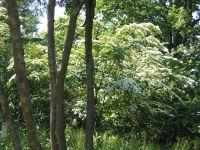Kousa dogwood - Cornus kousa
English name:
Kousa dogwood
Scientific name:
Cornus kousa
Family:
Cornaceae (Dogwood family)
Height:
up to 6 meters in Denmark
Flowering:
Late June early July
Range:
Japan, Korea and central China
 |
|
 |
 |
The flowering 42-year-oldCornus kousa in the picture can be found near the Lake road near the front gate of the Arboretum, in square 915 position 3232. Note the bark of the Cornus kousa which is visible in the foreground.
Plant description:
The genus Cornus (in the wide sense) comprises about 65 species. The genus has a broad natural range in the northern hemisphere and extends south to South America and Africa. The English name, dogwood, comes from the use of the wood for skewers or dogs. However, dogwoods can be shrubs, small trees or even herbaceous plants. The fruits of 15 species are red, while they are blue or white in the other species. The fruit of some, if not all, dogwood species are eatable and have been used to make jams and alcoholic beverages. The Arboretums collection contains 39 different dogwood species and we have 35 specimens of Cornus kousa. The wild collected specimens of Cornus kousa in our collection come from as far west as Shikoku in Japan and as far east as Hunan in China. Like elsewhere, the Chinese provenance produces the largest flowers and the has the most rapid height growth of the wild plants in our collection.
Cornus kousa benefits from being protected from the wind in our area and is slow growing, but otherwise it is extremely useful as a large garden bush or small garden tree. The branches are covered with flowers after the main blooming season has finished for most other plants. The leaves are bright red in the autumn and the pinkish-red strawberry-like fruits are also very attractive. Furthermore the bark exfoliates in irregular patches (as on Platanus stems) and is attractive even in winter. This is the best showy dogwood for the Danish environment.
The twigs are green-brown in the first year with short pale hairs that disappear by the next year. Leaves are ovate and opposite on the twigs, with about 4 pair of parallel, bowed veins. The margins of the leaves are wavy. The true flowers occur in rounded heads on 4-6 cm stalks held above the foliage. They are small but are subtended by four showy (normally white) bracts. The showy bracts are slender-pointed, in contrast to the other species one finds in Denmark with rounded bracts.
References:
Bean, W.J. 1976. Trees and Shrubs Hardy in the British Isles. Vol I. 8th edition, The Royal Horticultural Soc. Publisher pp. 703-4.
Mabberley, D.J. 1997. The Plant Book. Cambridge University Press, Cambridge, UK. Pp 184.
Poor, J.E. (ed.) 1984. Plants that merit attention Vol. I - Trees. Timber Press. Portland.
Rushforth, K. 1999. Trees of Britain and Europe. Harper Collins Publisher. Pp 521-522.
